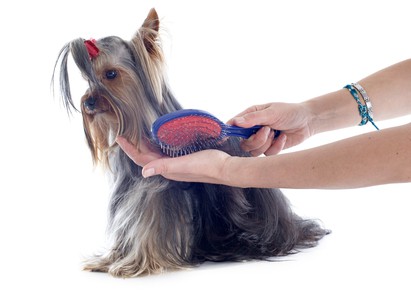Brushing and combing your Yorkie will be easier if you keep on a schedule and follow a pattern – and if you get your equipment together before you get started. You’ll need the following items:
- Spitzer bottle with a mixture of 1/4 coat conditioner and 3/4 water
- Steel comb with wide and fine teeth
- Pin brush
- Detangling spray
- Towel
Once you’ve gathered your supplies, round up your dog, turn up the soothing music, and try to relax. Then follow these steps:
- Place the dog on the towel and spritz the area you’ll be working on until it’s slightly damp. Never brush a dry coat, because it creates static electricity that causes tangles, and because a dry coat breaks more easily. Spritz down to the skin, lifting the coat in layers to reach it.
- With the dog on his side, lift the coat up so you’re looking at the hair that grows from the lower part of his body. Start brushing this lower coat first, beginning at the ends of the hair and working toward the skin. Use the pin brush first, then the wide-toothed comb, and finally the fine-toothed comb.
- When the lower layer is tangle-free, brush the layer above it into place and repeat the process. Continue doing this, adding in additional top layers, until you reach the top of the dog.
- Do the other side, or do the legs on the side you’re on.
- Do the head and tail.
- You can vary the order, but just remember what you’ve done!
Mats. Oh what a tangled web we weave – when unbrushed the coat we do leave! It could be the start of a tragic epic, the tale of the unbrushed Yorkie. That’s because brushing is more than cosmetic. It’s not uncommon for Yorkies to come into rescue or to groomers with coats so matted that they’ve caused health problems.
One common problem occurs when the dog’s rear end is never cleaned. Fecal matter gets caught in the coat and, the coat mats around it, until eventually the area is so matted that it entirely covers the anus, preventing proper defecation. Not only is this disgusting, but it can attract flies, which lay their eggs in the fecal matter that is now pressed into the skin, and maggots emerge and eat into the dog. If the mat is tight enough, it can cause impaction, preventing the dog from defecating because there’s no place for the feces to go.
Mats on other parts of the body can cause other problems. Mats tend to grow and compress as they age, recruiting more hair from their margins and pulling it into an ever-tightening mass. As this happens, it also pulls the skin that the hair is attached to. At best, it causes the dog to be uncomfortable; at worst, it prevents the dog from even walking because its legs are matted into place. And again, the area below the mat holds moisture and bacteria, setting up a playground for infections that may only be visible once the mat is removed, but are certainly painful to the dog all along.
Make brushing a part of your daily routine, perhaps as you watch television at night. It’s easiest if your Yorkshire is trained to lie in your lap, on the sofa beside you, or on a table that’s slightly higher than lap level. If you start early, your dog will look forward to these sessions and probably fall asleep during them. Start early with your puppy, using a soft brush and never pulling on tangles.
Trimming the Anal Area
Some trimming is for looks, but trimming around the anal area is for cleanliness. If this is the only trimming you ever plan to do yourself, you can buy an inexpensive mustache trimmer and use it to clip the hair short in an area about a half inch or so around the anus. If you already have clippers, you can use a #10 blade for this. You can also use blunt-nosed scissors.

